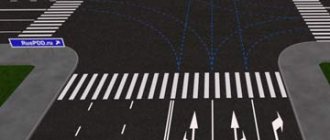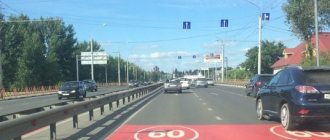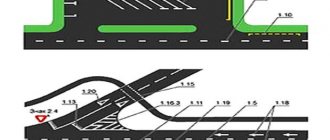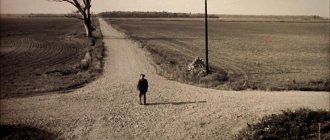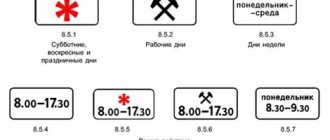If there are signs and markings on the road that contradict each other, then the driver must clearly navigate the situation and know what to give priority to. They may contradict each other in the event of an accident or during repair work on the road. Therefore, the driver must be careful not to create an emergency situation and navigate short-term traffic changes.
What is priority: sign or marking?
In order not to be mistaken with the primacy of signs on the road, you should distinguish between the types of road signs and markings. They can be permanent or temporary. But in any case, according to the rules, the driver must be able to see them at any time of the day. Signs should not be obscured by billboards or trees. Particular attention should be paid to signs that are installed illegally. They have no force and the driver should not take this information into account. Illegal signs include: those attached to a lamp post or tree using duct tape or tape. Such pointers must be ignored.
Temporary road signs and markings
It is easy for a motorist on the road to distinguish temporary road signs from permanent ones. Temporary signs have a yellow background, permanent signs have a white background. According to the traffic rules, there must be a sign under the temporary signs indicating the territory of influence of this informer and the distance to the problem area. Usually, at the end of the segment, sign 3.31 is installed, which removes all restrictions that were in force before it.
The temporary marking differs only in color - it is orange. Temporary indicators always take precedence over permanent ones, since they indicate the need for a certain movement in a specific situation. In this case, stationary signs are usually removed or covered so that they do not confuse drivers. Temporary signs are easier to install and can also be easily dismantled.
Permanent road signs and markings
Permanent signs are installed for a long time. They are designed to show information that will be relevant for a long time, regardless of external factors. Permanent signs must be installed in a specially prepared recess, which is then filled with concrete. Once the concrete has hardened, earth is poured around the sign. Unlike temporary signs, permanent signs inform about the features of movement on a given section of the road in the long term. Permanent markings have a white main background color inside the border.
If there are temporary and permanent informers on the site at the same time, then according to the traffic rules, temporary signs have priority for the driver, since they inform about the changed situation on this section of the road.
Important! If the lines painted on the road contradict the signs, then according to the traffic rules the latter have priority, while the markings are always of secondary importance.
Prioritization
If you prioritize, taking into account temporary and permanent signs, then the temporary road sign comes first, followed by the permanent one. In third place in terms of priorities is temporary marking and only then permanent marking.
On a road that has several lanes, according to traffic regulations, the sign must be located not only on the side, but also on the road so that drivers moving in the middle of the stream have access to this information.
What is more important – signs or markings?
Based on the last paragraph of Chapter 8 of Appendix 1 to the Traffic Regulations, we can state:
If the meanings of temporary and permanent road signs conflict, drivers should give priority to the temporary signs.
Chapter 8 of Appendix 1 to the Traffic Regulations
And the last paragraph of Chapter 1 of Appendix 2 to the Traffic Regulations says:
if the meanings of signs, including temporary ones, and horizontal marking lines contradict each other or the markings are not sufficiently distinguishable, the driver should take into account the road signs. If there are conflicts between temporary and permanent markings, priority is given to the first temporary one.
chapter 1 of appendix 2 to the traffic rules
The final list of priorities on the road is as follows:
1Temporary signs.
2Permanent signs.
3Temporary marking.
4Permanent marking.
Only road signs installed in accordance with the requirements relate to the rules of the road; the rest, in fact, are recognized as installed without sufficient grounds. A sign installed not in accordance with GOST is contrary to both the law and traffic regulations.
Thus, if the markings contradict the signs, you don’t need to think about what to do, you just need to be guided by the current traffic rules.
Examples of contradictions between signs and markings
There are several most common options when the two pointers in question contradict each other. Most often, permission is given to overtake vehicles in the oncoming lane if there is a double solid line and a temporary informer 4.2.2. Usually this combination is used when repairing a road. In this case, the priority will be to allow overtaking, despite the double solid line. There are other options for controversial situations.
Overtaking at sign 3.20 and markings 1.5
Plate 3.20 means that overtaking is prohibited on this section of the road. Marking 1.5 is a broken line allowing overtaking and detour. A broken line is used on two-lane roads as well as on three-lane roads to indicate lanes. Despite the fact that such a line is a “center line,” on two-lane roads it can be crossed and overtaken. But only if there are no additional signs that contradict the lines marked on the road.
If these conflicting information messages are combined on one section of the road, then the driver should not overtake, focusing on the prohibitory sign. But the markings in this case are of particular importance; they allow overtaking or detour:
- slow-moving vehicles;
- horse-drawn transport;
- motorcycles without trailers.
It is the dotted strip that indicates the effect of these exceptions. In this situation, it will not be overtaking, but rather a detour.
Overtaking at sign 3.21 and markings 1.1
The situation is the opposite of the previous one. In this case, symbol 3.21 indicates the end of the overtaking zone, and marking 1.1 is a solid line that cannot be crossed, which means you cannot overtake. In this case, the line will have priority, since the sign does not indicate that overtaking is allowed. It simply indicates the end of the no-overtaking zone. By and large, these informers do not contradict each other, but complement each other.
Important! In bad weather conditions and poor visibility, the driver may not notice the solid line, but will first pay attention exclusively to indicator 3.21. In this case, it is necessary to use regulatory documents to prove the innocence of the motorist.
What are the actions of traffic police officers if there is a contradiction between a sign and markings?
Usually, in places where they decide to install temporary road signs, similar road markings are drawn, and in addition, traffic police officers often work there. This fact is caused by the need to control the actions of drivers. If you ignore the established signs, you will be punished.
When a driver is given sanctions due to traffic violations that are caused by these factors, then each car owner has the right to appeal the decision of the traffic police officer , which are based on the following situations:
- permanent markings are difficult to see due to weather or mechanical defects, and there are no signs along the route that could theoretically control the movement of cars;
- The road sign has greatly faded and was otherwise deformed, which is why it is impossible to see what exactly is depicted on it, and there are no other markings for reference on the road.
Therefore, it is quite logical that if the driver does not intentionally violate traffic rules (especially when this is caused by the absence or terrible visibility of installed signs), then the citizen has every right to challenge the police decision in the standard manner.
What to do if there are contradictions?
First of all, the driver should calm down and not panic. Only in this case will it be possible to make the right decision. If there is an obvious contradiction between the sign and the markings, the priority is always the temporary sign, since it indicates the desired actions depending on specific circumstances (road repairs, accidents, weather conditions, emergency situations). The markings in relation to the sign are always secondary, and this is conveyed to drivers during training at a driving school. It is important to remember this material and use it.
Permanent road signs and markings
Permanent signs provide necessary information to the driver. They differ from temporary ones in color and installation method. It cannot be yellow.
To install them, a hole of the required depth is dug, into which the sign is placed and filled with concrete. After the concrete mixture has hardened, the hole is filled with soil - this is the final stage of installation.
It is almost impossible to move, so it is installed for a long period of time.
Permanent road markings are also applied over a long period of time and decorated with a thick layer of white paint.
It is almost impossible to remove it from the road surface, since it must be constantly present on the road surface and facilitate the fast and safe movement of cars on a given section of the road.
It has the same purpose as temporary, but is characterized by a wider distribution.
Responsibility for failure to comply with priorities
If a motorist does not comply with priorities, he faces administrative punishment in the form of a fine. The fee for failure to comply with the requirements of markings or road signs is 500-1500 rubles.
If the sign required you to stop, turn around or turn, the fine increases from 1000 rubles to deprivation of your driver’s license. If the driver believes that he was fined unlawfully and did not violate the priority, then within 10 days he has time to file a complaint and protest the inspector’s decision.
Conflicting information on the road can confuse even experienced drivers. But traffic regulations have clear instructions in this regard: a temporary sign is a priority, since it indicates the necessary actions depending on specific changed road conditions. Most often there is a contradiction with the prohibition and permission of overtaking. If there is a temporary sign on the road prohibiting overtaking, the markings in this case do not matter. It is better for the driver to take his time and not cross the line.
Temporary road signs and markings
A distinctive feature of temporary signs is their yellow background . Temporary road signs are installed on a portable stand.
In most cases, they are used in areas where the road surface is being repaired or when a traffic accident occurs, as this interferes with the normal movement of traffic in the area.
The basis of the temporary sign is crossed iron reinforcement at a 90 degree angle . The length of the base elements is 500 millimeters.
The resistance of the element to wind and vibration from vehicles passing nearby is ensured through the use of metal components.
Sometimes, for reliability and higher stability, a weight is mounted at the base of the sign. For this purpose, a metal weight or a concrete stone can be used.
It is worth considering that temporary road signs do not include those that are taped to a post or attached to a tree.
Road markings are paint on the surface of a highway or highway, applied to regulate the movement of vehicles along a given area.
The peculiarity of temporary road markings is that they are made for a short period of time and are applied to the road surface with orange paint. Rarely used, but worth knowing about.
General rules for signs and markings
Over the past few years, the rules for resolving conflicts between road signs and road markings have changed several times.
At first it was like this. In case of contradictions between a temporary sign and road markings, drivers had to be guided by the temporary signs. That is, the temporary sign was more important than the marking. Please note that we are talking about a temporary sign. In case of contradictions with a permanent sign, the road markings were more important.
Then for several years it was like this: in cases where the meanings of road signs, including temporary ones (placed on a portable support), and horizontal marking lines contradict each other or the markings are not sufficiently distinguishable, drivers must be guided by the road signs. This meant that if the temporary sign was not placed on a portable support, then the road markings had to be followed, that is, the markings were more important in these relatively rare situations. But if the sign was placed on a portable support, then the sign was more important.
Finally, in December 2021, the Government of the Russian Federation clarified the Traffic Rules. There is unambiguity in resolving contradictions between signs and markings. Now, in cases where the meanings of road signs, including temporary ones, and marking lines contradict each other, drivers must be guided by the road signs. This means that the sign has become more important than the markings in all situations, regardless of whether the sign is temporary or permanent, and on what support it is located.
To summarize the above, we note that currently any signs (permanent, temporary, temporary on portable stands) have unconditional priority over marking lines, that is, signs are always more important than markings.
Behavior of traffic police officers during a conflict between markings and signs
It is common to find traffic police in areas where temporary signs have been installed or non-permanent horizontal lines have been painted. Their task is to control the behavior of traffic participants.
If the driver ignores the temporary signals, he will be punished in the form of monetary sanctions. However, there are a number of situations when a motorist brought to administrative responsibility can challenge the order of traffic police officers:
- permanent markings are not visible due to snow or mud, and there are no additional signs to help regulate traffic on the side of the road;
- there are no horizontal lines, and the design on the plate is not visible (for example, the pointer has faded).
Road signs and horizontal markings are mandatory attributes that help traffic participants navigate the path. In most cases, they work in a duet, demonstrating the same information. But if there is a conflict between signals, there is no need to panic. It is better to remember the “Rules of the Road”, which read:
- the permanent plaque is more important than the timeline;
- a short-term sign “takes precedence” over stationary markings and signs;
- temporary horizontal lines are more important than permanent signals and markings.
And so that such situations do not cause difficulties, it is important to repeat the “Rules of the Road” from time to time.
What is more important, the markings or the sign?
Road signs are fixed by the Rules of the Road. Their purpose is to guide drivers for the safest possible movement on the roads.
Designations can be temporary or permanent. If both are available at the same time, preference is given to temporary ones, and the following order of priority applies:
- Temporary signs.
- The signs along the road are permanent.
- Markings applied to the roadway for a certain period of time (temporarily).
- Permanent marking.
From this we conclude that the first thing you should pay attention to is the signs installed along the roadway, and only then be guided by the lines marked on the road.
If temporary signs conflict with the markings or they are poorly visible on the road, then the driver must follow the signs. When applying temporary road markings that conflict with permanent ones, you need to rely on the temporary ones.
Most often, temporary road control measures are established for a short period of time. This is usually associated with repair work on the roadway, improvement of adjacent shoulders, or replacement of the road surface, which is scheduled for more than three days.
The purpose of non-permanent signs and markings is to warn drivers that for a certain period of time:
- the situation on a particular section of the road has changed;
- the movement is organized differently.

